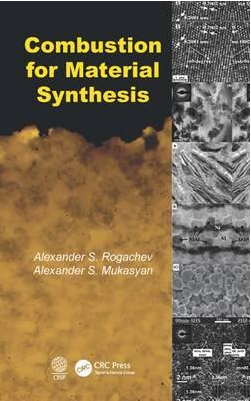
Combustion for Material Synthesis
[BOOK DESCRIPTION]
Exposes a Powerful Material-Making Tool Dedicated to the physical, chemical, and structural transformations that take place during combustion synthesis (CS) of advanced materials, Combustion for Material Synthesis analyzes the nature of solid flame phenomenon and provides readers with undisputed proof that 'fire' is a powerful tool used in making materials. Of interest to specialists in the field of materials engineering, this book explores the physical and chemical principles of synthesis of materials in the self-sustained combustion mode. It describes mechanisms for a variety of solid-solid and gas-solid reactions and examines structure and properties of different materials produced by CS. The authors discuss a wide range of topics, including phenomenology, theory, experimental methods and observations, as well as properties of the product synthesized and approaches for large-scale materials production using the combustion synthesis technique. They examine conventional concepts and present recent breakthroughs in the field of materials synthesis by rapid self-sustained reactions that include fabrication of different nanomaterials.They compare CS with other methods, factoring in different types of combustion processes, including processes that can occur in a vacuum, inert gas, or oxygen-free atmosphere. Covering research on topics that have been around for a while, but not widely circulated, this work: * Outlines in detail both fundamental aspects of CS, including modern theoretical approaches and advanced in situ experimental methods * Examines the advantages and disadvantages, achievements, and challenges remained in heterogeneous combustion used for material synthesis * Explores the emergence of a new fundamental direction in material science, i.e., structural macrokinetics * Details new technologies that are based on fundamental scientific discoveries and innovative scientific ideas * Analyzes structure and properties of variety of CS materials, including nanomaterials Authored by world-recognized specialists in the field of combustion synthesis for advanced materials, Combustion for Material Synthesis presents the state of the art in R&D in the field of CS, focusing on the fabrication of novel materials.It is intended for researchers, engineers, and graduate students from different disciplines and is also suggested as recommended reading for materials science courses.
[TABLE OF CONTENTS]
1 Self-propagating High-temperature 1 (43)
Synthesis: History and Present
1.1 Discovery 1 (3)
1.2 Gasless combustion synthesis 4 (5)
1.3 Combustion synthesis with 9 (2)
gasification of the reagents
1.4 Combustion synthesis in gas--solid 11 (7)
systems
1.5 Combustion synthesis with a reduction 18 (7)
stage: the thermite type systems and
nanothermites
1.6 Combustion synthesis with inorganic 25 (2)
compounds as precursors
1.7 Thermal decomposition of complex 27 (5)
compounds
1.8 Solution combustion synthesis 32 (2)
1.9 Mechanical activation of initial 34 (3)
powder mixtures for SHS
1.10 Reactive multilayer nanofilms (foils) 37 (7)
2 Thermodynamics and Kinetics of SHS 44 (81)
2.1 Introduction 44 (1)
2.2 Thermodynamics and driving force of 45 (45)
SHS processes
2.2.1 Thermodynamics of SHS systems 45 (1)
2.2.1.1 General principles 45 (9)
2.2.1.2 Equilibrium, reversibility, 54 (5)
stationary and stability of the SHS
processes and products
2.2.1.3 The equilibrium composition of 59 (6)
the SHS products and the adiabatic
combustion temperature
2.2.1.4 Examples of thermodynamic 65 (12)
calculations for SHS systems
2.2.2 Thermodynamics of the 77 (9)
preheating--reaction zone
2.2.3 The thermodynamics of the 86 (4)
reaction cell
2.3 Kinetics of heterogeneous reactions 90 (35)
2.3.1 Solid-state reactions 93 (7)
2.3.2 Solid--gas reactions 100(15)
2.3.3 Reactions with the liquid phase 115(1)
2.3.4 Reactions with gasification of 116(3)
the initial solid phase reagent
2.3.5 Methods of high-temperature 119(6)
kinetics of heterogeneous reactions
3 Theory of Structural Macrokinetics 125(80)
3.1 Introduction: The concept of 125(3)
structural macrokinetics
3.2 Macrokinetics of thermal explosion 128(8)
3.3 Macrokinetics of combustion 136(32)
3.3.1 Homogeneous and quasi-homogeneous 136(13)
combustion models
3.3.2 Microheterogeneous combustion 149(19)
theory of gasless systems
3.4 Theoretical models of structure 168(35)
formation in SHS
3.4.1 Structure formation in gasless 168(1)
combustion
3.4.1.1 General concepts 168(1)
3.4.1.2 Mass transport of reagents in 169(4)
the reaction cell: melt spreading
3.4.1.3 Transport of reagents in the 173(3)
reaction cell: capillary impregnation
3.4.1.4 Transport of reagents in the 176(2)
reaction cell: coalescence of the
droplets
3.4.1.5 Transport of reactants in a 178(12)
reaction cell: mass transfer in the gas
phase
3.4.1.7 Evolution of the product 190(1)
microstructure in the post combustion
zone (secondary structure formation)
3.4.2 Structure formation in hybrid 191(3)
solid--gas systems
3.4.2.1 Model of structure formation 194(5)
during combustion of metals with
nitrogen
3.4.2.1 Models of structure formation 199(4)
during combustion of non-metals in
nitrogen
3.5 Conclusion 203(2)
4 Experimental Structural Macrokinetics of 205(126)
SHS Processes
4.1 Experimental methods 205(16)
4.1.1 Basic principles of experimental 205(3)
diagnostics of SHS processes
4.1.2 Combustion wave velocity and 208(2)
temperature--time profiles
4.1.3 Preparation of samples with a 210(3)
quenched SHS wave
4.1.4 Experimental modelling of the 213(3)
reaction cell
4.1.5 Dynamic electron microscopy 216(1)
4.1.6 Time-resolved X-ray diffraction 217(4)
(TRXRD)
4.1.7 Other methods 221(1)
4.2 Experimental results 221(110)
4.2.1 Dynamics of phase and structural 221(9)
transformations during the thermal
explosion mode
4.2.2 Macrostructure of reacting media 230(13)
and of combustion front in
self-propagating mode
4.2.3 Gasless combustion: evolution of 243(1)
micro- and crystal structures
4.2.3.1 Primary structure formation 243(19)
4.2.3.2 Post-combustion processes and 262(6)
secondary structure formation
4.2.4 Evolution of the microstructure 268(1)
and phase composition and crystal
structure during infiltration combustion
4.2.4.1 Titanium--nitrogen system 268(7)
4.2.4.2 Niobium--nitrogen system 275(6)
4.2.4.3 Aluminium--nitrogen system 281(4)
4.2.4.4 Silicon--nitrogen system 285(9)
4.2.4.5 Boron--nitrogen system 294(4)
4.2.5 Experimental data on the 298(12)
thermite-type systems
4.2.6 Experimental data on sol--gel 310(5)
systems
4.2.7 Experimental data on mechanically 315(6)
activated systems
4.2.8 Experimental data on the reactive 321(6)
multilayer nanofilms
4.2.9 Thermal microstructure of the 327(4)
combustion wave
5 Commercialization and Industrial 331(26)
Applications of SHS Products
5.1 Introduction 331(1)
5.2 Powders and cakes 332(10)
5.3 Ceramic materials 342(7)
5.4 Cermets and functionally graded 349(2)
materials
5.5 Products of SHS metallurgy 351(1)
5.6 Application of multilayer reaction 352(2)
nanofilms
5.7 Conclusion 354(3)
Endnotes 357(2)
References 359(35)
Index 394

 新书报道
新书报道